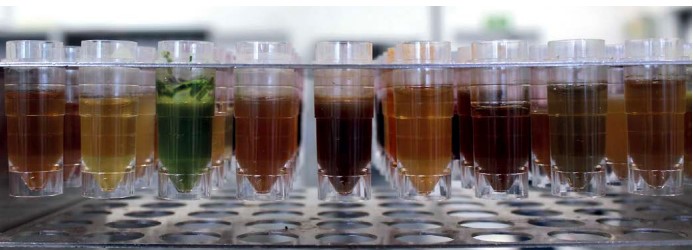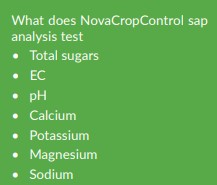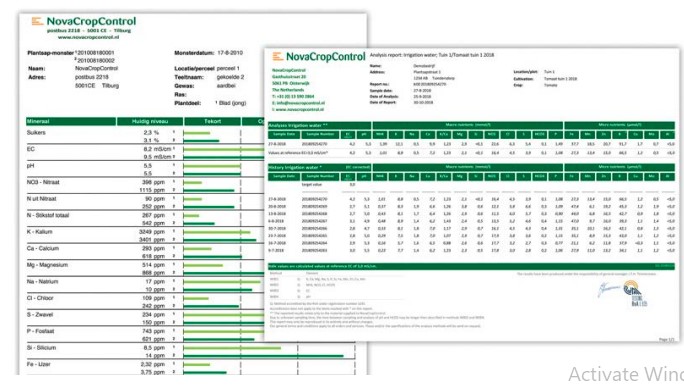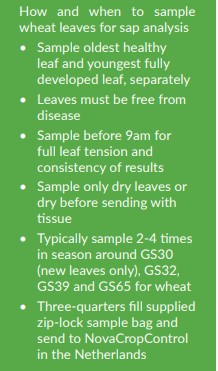Maintaining plant health to reduce inputs is a key goal for many regenerative systems. In this series of articles
Mike Abram explores how plant sap analysis could help deliver this

Much like with our own health a balanced diet is important for maintaining health and ultimately maximising yield and quality of crop plants. Some of the macro- and micronutrients the plant takes up are used to power photosynthesis – energy production in the plant – while others facilitate the conversion of the sugars produced by photosynthesis into a whole range of other plant compounds. These include defence materials, such as anti-feedants, cell strengtheners, physical barriers, and root exudates to recruit microbial communities to help protect plants from attack. To build these defences nutrients are needed in various quantities ranging from kilograms of macronutrients such as nitrogen, phosphorus and potassium to grams of micronutrients like copper and zinc.
A deficiency or excess of any of these can limit photosynthesis and / or these other plant compounds, including both passive and active defences. But understanding whether a plant is receiving a balanced diet of nutrition is no easy matter. Soil nutrient analysis gives a picture of what is present in the soil at that point, but not necessarily what is available to the plant to take up. Plant tissue (dry matter) tests during the growing season are another potential source of information. These measure all the mineral nutrients stored in the sampled leaf, and are particularly helpful for understanding the success of nutrient applications at the end of the season. But again, it doesn’t just measure what is available to the plant at the testing point, as it also measures the nutrients stored in the leaf, which are much less available to be used for plant development.
Wanting to determine just the nutrient fraction that was available for plant development was the starting point for the development of plant sap analysis by Dutch company NovaCropControl back in 2009. Its sap analysis service provides, what it says, is a more accurate way of measuring the nutrients available to the plant at the time of sampling. The advantage of only measuring what’s available to the plant is that it shows up potential deficiencies earlier – perhaps one to two weeks earlier – than tissue analysis, says Eric Hegger, a consultant with NovaCropControl. “In a tissue test a big part of what is being measured are the stored nutrients in the leaf, which cannot be used any longer,” he explains. The test is crop agnostic. If the crop is green and growing, and the firm can extract sap, it’s possible to do sap analysis, with over 200 crops covered.
“Most growers start with sap analysis because they want to know and manage their nutrient uptake from the soil to improve their fertiliser efficiency, and to avoid nutrient deficiencies or toxicities before they are visible in the plant,” he says. “Ultimately we want to save costs through optimum plant growth, health and quality.” Sap analysis tests for 16 different nutrients, including three ways of measuring of nitrogen, plus total sugars, the total dissolved salts (EC) and pH (see box).


Sampling is important – there are some basic rules to get it right to deliver the best results. These include sampling before 9am in the morning for full leaf tension and ensure consistency of results. The leaves must be dry – or dried with a tissue before sending – and free from dirt and disease, with the petiole or stalk that attaches the leaf to the stem removed. The analysis also compares young and old leaves, which must be sampled separately. If deficiency is showing sample these leaves separately from healthy ones. “That will give the best insight into what is the deficiency. “If you do a foliar spray then either sample before to help understand what correction to do or at least one week after, as there will always be residue on the leaves and this will influence the results,” adds Mr Hegger.

Samples should be sent in clean zip-lock bags, preferably using labels supplied by NovaCropControl. Around 85g is required for a wheat leaf sample. Delays in getting the samples to the Netherlands was an issue for some growers last season with changes in Customs rules following Brexit. Help and instructions for sending samples from outside of the European Union can be found on the NovaCropControl website.

“The main issue with delays of more than three to four days is with the quality of the leaves. As soon as the leaves are picked they start to decompose, and the longer they are in transport the more that occurs. It mainly increases ammonium levels and also the pH of the crop – the rest won’t really change.
“But the better the quality the leaves reach us, the better the results.”
• In part 2 next issue, we look at the science behind plant sap analysis to understand nutrient use in plants
